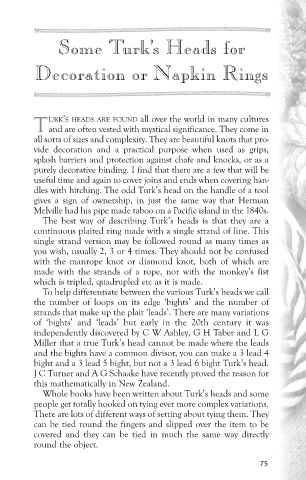Page 76 - Des Pawson "Des Pawson's Knot Craft" 2 edit.
P. 76
KNOTCRAFT 2009:Layout 1 23/10/09 12:17 Page 75
Some Turk’s Heads for
Decoration or Napkin Rings
URK’S HEADS ARE FOUND all over the world in many cultures
Tand are often vested with mystical significance. They come in
all sorts of sizes and complexity. They are beautiful knots that pro-
vide decoration and a practical purpose when used as grips,
splash barriers and protection against chafe and knocks, or as a
purely decorative binding. I find that there are a few that will be
useful time and again to cover joins and ends when covering han-
dles with hitching. The odd Turk’s head on the handle of a tool
gives a sign of ownership, in just the same way that Herman
Melville had his pipe made taboo on a Pacific island in the 1840s.
The best way of describing Turk’s heads is that they are a
continuous plaited ring made with a single strand of line. This
single strand version may be followed round as many times as
you wish, usually 2, 3 or 4 times. They should not be confused
with the manrope knot or diamond knot, both of which are
made with the strands of a rope, nor with the monkey’s fist
which is tripled, quadrupled etc as it is made.
To help differentiate between the various Turk’s heads we call
the number of loops on its edge ‘bights’ and the number of
strands that make up the plait ‘leads’. There are many variations
of ‘bights’ and ‘leads’ but early in the 20th century it was
independently discovered by C W Ashley, G H Taber and L G
Miller that a true Turk’s head cannot be made where the leads
and the bights have a common divisor, you can make a 3 lead 4
bight and a 3 lead 5 bight, but not a 3 lead 6 bight Turk’s head.
J C Turner and A G Schaake have recently proved the reason for
this mathematically in New Zealand.
Whole books have been written about Turk’s heads and some
people get totally hooked on tying ever more complex variations.
There are lots of different ways of setting about tying them. They
can be tied round the fingers and slipped over the item to be
covered and they can be tied in much the same way directly
round the object.
75

